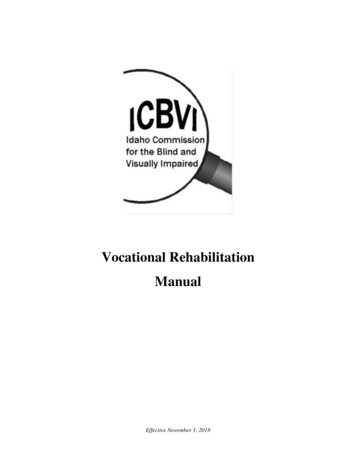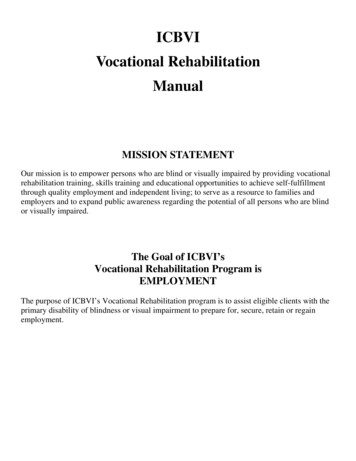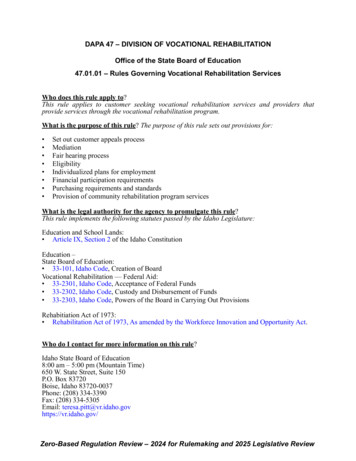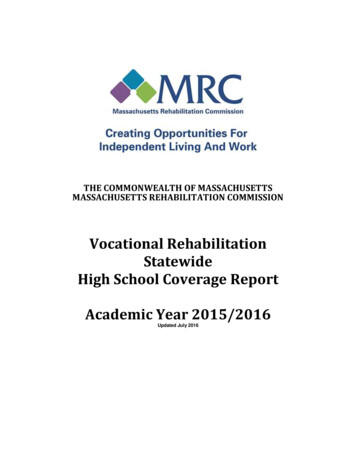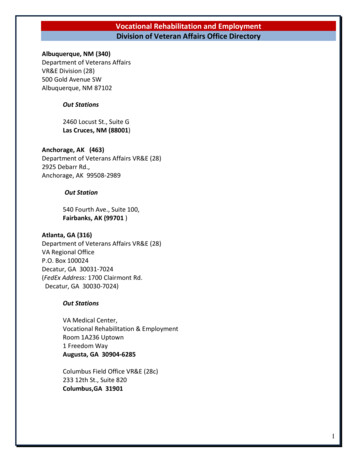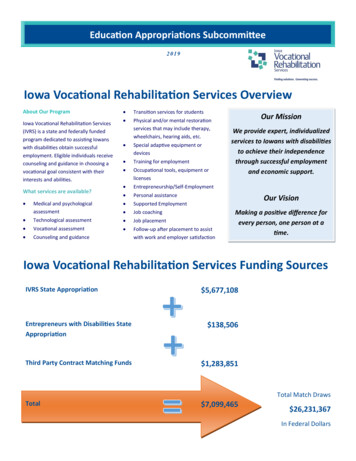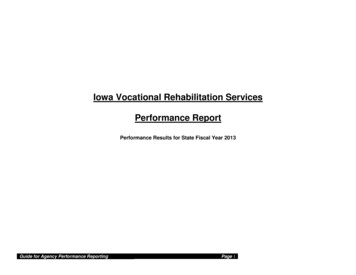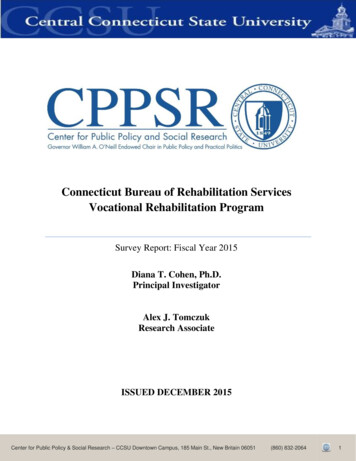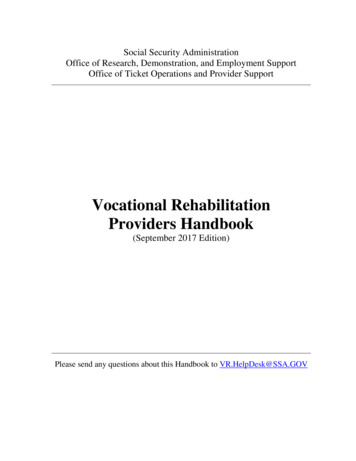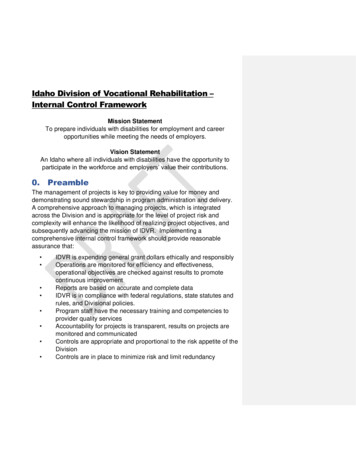
Transcription
Idaho Division of Vocational Rehabilitation –Internal Control FrameworkMission StatementTo prepare individuals with disabilities for employment and careeropportunities while meeting the needs of employers.Vision StatementAn Idaho where all individuals with disabilities have the opportunity toparticipate in the workforce and employers’ value their contributions.0.PreambleThe management of projects is key to providing value for money anddemonstrating sound stewardship in program administration and delivery.A comprehensive approach to managing projects, which is integratedacross the Division and is appropriate for the level of project risk andcomplexity will enhance the likelihood of realizing project objectives, andsubsequently advancing the mission of IDVR. Implementing acomprehensive internal control framework should provide reasonableassurance that: IDVR is expending general grant dollars ethically and responsiblyOperations are monitored for efficiency and effectiveness,operational objectives are checked against results to promotecontinuous improvementReports are based on accurate and complete dataIDVR is in compliance with federal regulations, state statutes andrules, and Divisional policies.Program staff have the necessary training and competencies toprovider quality servicesAccountability for projects is transparent, results on projects aremonitored and communicatedControls are appropriate and proportional to the risk appetite of theDivisionControls are in place to minimize risk and limit redundancy
Internal and external stakeholders have an opportunity formeaningful input and that input is seriously considered by theDivisionState and Federal reports are based on reliable data anddecisions are driven by reliable dataTimely outcomes are achievedSensitive customer data are protectedObjectiveThe objective of this internal control framework is to providereasonable assurance that appropriate systems, processes and controls formanaging the state-federal VR grant are in place throughout IDVR andsupport the achievement of objectives while limiting risk to customers andother stakeholders.Documentation StructureThis document (the ICIF Master Narrative) provides a high-level overviewof IDVR’s internal control framework. Linkages of principles andstatements found in this document to supporting documentation can befound under the associated component folder maintained on IDVR’sintranet here:C0 Other – Non-discrete Internal Control Activities that do not align into asingle category or Green Book elementC1 Control EnvironmentC2 Risk AssessmentC3 Control ActivitiesC4 Information & CommunicationC5 Monitoring ActivitiesICS Annual Assurances (ICS Design Adequacy Review/ICS EffectivenessReview).These documents in conjunction with supporting documentation eithersystematically address the components, principles, and attributescontained within the Green Book, provide rationale for not addressing a
principle, or do not discretely align with a principle due to project scope andare addressed separately.Definition of Internal ControlInternal control (IC) encompasses the plans, methods, policies, andprocedures used to realize the mission, strategic plan, goals and objectivesof IDVR. IC is a dynamic, iterative, and integrated process, effected by allemployees of the Division, and is used by management to achieve evolvingobjectives on an ongoing basis as a part of the continuous improvementand compliance activities of IDVR. An internal control frameworkrepresents the agency’s plan to meet the following requirements of 2 CFR§ 200.303 providing reasonable assurance of: IDVR’s compliance with Federal statutes, regulations and theterms and conditions of the Federal awardsEvaluation and monitoring of IDVR’s compliance on an ongoingbasisTimely action is taken when noncompliance is identifiedPersonally identifiable information (PII) and other sensitive dataare protected consistent with applicable laws and regulationsEffective and Compliant Framework RequirementsThe Uniform Administrative Requirements, at 2 CFR §200.303 mandate thecreation and maintenance of an effective internal control framework. Morespecifically, the regulations require an alignment with the “Standards forInternal Control in the Federal Government” (aka the Green Book)published by the Comptroller General of the United States and the “InternalControl – Integrated Framework” issued by the Committee of SponsoringOrganizations of the Treadway Commission (COSO). IDVR uses theGreen Book and COSO’s Integrated Framework documents throughout thisinternal control framework, including adherence to the requireddocumentation of IC activities outlined in the Green Book.Commented [MM1]: Need written policy on this in thebooks per 34 CFR 361.38(a)
Figure X. The Five Components and 17 principles of Internal ControlThe Green Book’s components and principles should be applied across allIDVR operations, reporting and compliance objectives. Any omission of theapplication of a principle must be addressed, justified and documented byIDVR’s oversight body.
Figure 1: The Components, Objectives, and Organizational Structure of InternalControl. United States Government Accountability Office (GAO), 2014.The Green Book explains that IDVR’s objectives are directly related to thefive components of internal control and the Division’s organizationalstructure:From the Green Book overview 2.04: The five components represent thehighest level of the hierarchy of standards for internal control in the federalgovernment. The five components of internal control must be effectivelydesigned, implemented, and operating, and operating together in anintegrated manner, for an internal control system to be effective. The fivecomponents of internal control are as follows:1. Control Environment - The foundation for an internal control system.It provides the discipline and structure to help an entity achieve itsobjectives.2. Risk Assessment - Assesses the risks facing the entity as it seeks toachieve its objectives. This assessment provides the basis fordeveloping appropriate risk responses.
3. Control Activities- The actions management establishes throughpolicies and procedures to achieve objectives and respond to risks inthe internal control system, which includes the entity’s informationsystem.4. Information and Communication- The quality informationmanagement and personnel communicate and use to support theinternal control system.5. Monitoring- Activities management establishes and operates toassess the quality of performance over time and promptly resolve thefindings of audits and other reviews. Objectives represent what IDVR wants to achieve, they can beoperational, reporting or compliance objectives (or a combination).The five components of IC (Control environment, risk assessment,control activities, and information/communication) are required forthe agency to achieve these objectives.The organizational structure includes the various operating units,operational processes and management structures available touse in achieving these objectives.o Every Division employee has a role in IC, however IC rolesgenerally fall into one of the following: Oversight body: Responsible for overseeing the strategicdirection and accountability of IDVR to include the design,implementation, and operation of this IC system. Management: Directly responsible for all activities ofIDVR including the design, implementation andeffectiveness of the IC system. Personnel: Assist in IC design, implementation andoperation. Responsible for reporting issues with meetingobjectives. External Auditors are not a part of IDVR’s IC system, butcan help note recommendations for improving the ICsystem. Findings/weaknesses identified by externalauditors, however, will be addressed through thisframework.
Defining Operations, Reporting and Compliance Objectivesfor IDVR:Objectives are established by management with the in conjunction withIDVR’s oversight body. Objectives relate to the mission, strategic plan andgoals of IDVR as well as achieving regulatory compliance. OperationalObjectives established by the agency must be specific, measurable andinclude targets. IDVR considers compliance and data reliability objectivescompulsory, and consequently sets targets for compliance at 100 percent.The scope of operational objectives included in IDVR’s work plan/riskmitigation plan will be a function of the risk appetite of the agency and theagency’s ability to conduct effective monitoring without having a significantnegative impact on the day-to-day field operations. Minimum allotmentagencies like IDVR have fewer resources to dedicate to oversight and mustbalance control activities and the ability to conduct business. Furthermore,due to the size of the agency, separation of duties is an essentialconsideration in the assignment of responsibility for objectives.Management may set subobjectives forregions/offices/caseloads/individuals when applicable. This document inparticular covers entity level controls (those controls which are applicableglobally across the Division).The Green Book categorizes objectives into three non-discrete categories:Operations, Reporting and Compliance (2 CFR 200.61): Operational objectives are focused on improving the effectiveness(improved outcomes) and/or efficiency (reduced waste) of businessoperations and are mission driven. Reporting objectives work to promote the reliability of reports (e.g.RSA-911, SF-425, RSA-2, ETA-9169) and ensure the agency ismaking decisions based on quality data. Compliance objectives (2 CFR 200.62) work to meet therequirements of germane program laws and regulations (to includeprescribed/mandatory objectives). Again, IDVR management mustconsider compliance objectives comprehensively before balancingcontrols and workload.Commented [MM2]: Fiscal must haves plus termsand conditions of grant and compliance with associatedregulations (will follow fiscal and other federal regs)
Normative References for IDVR’s Internal ControlFramework (External References)Standards for Internal Control in the Federal Government (the “GreenBook”) GAO-14-704G (U.S. Government Accountability Office, 2014)online: https://www.gao.gov/products/GAO-14-704GInternal Control – Integrated Framework (2013). Committee of SponsoringOrganizations of the Treadway Commission. g COSO Across the Three Lines of Defense (2015). Anderson,D.J. & Eubanks, G. idance on Monitoring Internal Control Systems (2009). Committee ofSponsoring Organizations of the Treadway Commission
C1. CONTROL ENVIRONMENTThe control environment sets the tone at a company through a set ofagency standards, processes and organizational structure that provides thebasis for successful internal control execution. It is the foundation for allother components of internal control, providing structure, feedback anddiscipline. The standards of conduct and the importance of internal controlmust be exemplified by the oversight board and administration and shouldbe reinforced by management within all levels of the organization. Integrityand ethics should be core values throughout the organization. How IDVRhandles governance oversight, assignment of authority, and personnelperformance programs have a pervasive impact on internal control.Required Principles for an Effective Control EnvironmentPrinciple 1: Demonstrate Commitment to Integrity andEthical ValuesAdministration Philosophy (1.1)Responsive, transparent, honest, and efficient government areexpectations Idahoans have for their state government and IDVRrecognizes the critical importance of ethical conduct and integrity inrealizing these expectations and furthering our mission. The commitmentto doing the right things in the right way for the right reasons is one thatbegins with Division Administration and is a pervasive expectationthroughout the Division. IDVR has established standards, policies andprocedures to promote integrity in government. IDVR relies on coreprinciples and values to resolve unique ethical issues and expects allagency staff to commit to these standards.Established Standards of Conduct (1.1.6)IDVR maintains administrative, field services, information technology,training and human resource policies in order to outline the expectedbehavior of all IDVR employees. These policies help frame the Division’scontrol framework by ensuring all employees understand the expectationsrelating to ethical conduct, integrity and professionalism includingadherence to published standards.
Linking Document (ConEnv-001-01) contains comprehensive references toestablished policies outlining standards of conduct and ethicalrequirements.Standard Dissemination and Standard Awareness (1.1.06-1.07)Staff are required to certify the review of policy, articulating ethical andother behavioral standards at hire and then again annually (depending onthe policy in question). New employees for example must certify theirreview of IDVR’s Personally Identifiable Information (PII) policy on day one,prior to interfacing with any PII. A comprehensive list of new employeerequirements and annual requirements of policy review can be found[HERE]. This approach promotes the dissemination of agency standardsand in many cases defines ethical conduct.Awareness and identification of potential fraud opportunities/ethicalconflicts in the field are essential prerequisites toward appropriately andsystematically addressing potential risks. IDVR administration envisions anagency culture where communication occurs among all employees andwhere issues are raised and resolved in a timely and ethical manner. Thisvision is embodied in IDVR’s ‘Open Door Policy’ which outlines proceduresfor addressing employee concerns and helps establish the tone at the topfor the agency.The Code of Professional Ethics for Rehabilitation CounselorsEthical codes can be helpful in framing the expected behavior ofprofessions and promoting integrity within organizations. IDVR uses twoprimary documents to inform the agency’s approach to promoting ethicalconduct as outlined in Section 2.0 of IDVR’s Field Services Policy Manual.First, IDVR requires all field staff to observe the enforceable standards ofethical practice articulated in the Code of Professional Ethics for CertifiedRehabilitation Counselors (the CRC Code) relating to:A. The counseling relationshipB. Confidentiality, privileged communication and privacyC. Advocacy and accessibilityD. Professional responsibilityE. Relationships with other professionals and employersF. Assessment and evaluationG. Supervision and training
H. ResearchI. Technology, social media, and distance counselingJ. Business practices andK. The resolution of ethical issues to include reporting responsibilities,conflict resolution, handling ethical violations, and protections forwhistleblowersIDVR believes heightened professional expectations should be a part ofworking with vulnerable populations and consequently expects all staff toadhere to these standards.These enforceable standards represent a minimum level of expectedbehavior for IDVR staff and violations can form the basis for correctiveaction. The Code is designed to be used by rehabilitation professionals,and qualified rehabilitation professionals working for IDVR hold CertifiedRehabilitation Counselor status meaning they can be held to theenforceable standards in the code and potentially sanctioned for unethicalor ethically questionable behavior by CRCC itself. Sanctions for unethicalbehavior under the code by non-CRC employees of IDVR would fall underIDVR policy.The CRC Code also articulates aspirational principles and values (P1.04)which staff can use to help guide decision-making, particularly when ethicaldilemmas arise. These include the principles of autonomy, beneficence,fidelity, justice and nonmaleficence. Training in ethical-decision makingapproaches is also a requirement of the code and an expectation of theDivision and staff are encouraged to use these principles to inform ethicaldecisions that are not specifically addressed by published standards.The values of the CRC code include a commitment to human rights anddignity, promoting the integrity of all professional relationships, promotingempowerment of our customers, understanding diversity, and the fair andadequate provision of services. IDVR infuses ethical considerations intostaff training whenever possible with a focus on practical examples andexercises. Additionally, those Certified Rehabilitation Counselorsemployed by the Division are required to have 10 continuing educationhours in ethics every five years to maintain their ethical knowledge anddecision-making skills. These values and principles are well aligned with
the expectation of management and administration and along with theenforceable standards are known agency wide.Internal Control Requirements: State and Federal MandatesSection 2.0 of IDVR’s Field Services Policy Manual requires adherence tothe second primary reference for IDVR’s control environment: the State ofIdaho’s Ethics in Government manual. This document mandates anyethical question include three further filters when attempting resolution:1. The Bribery and Corrupt Influence Act2. The Prohibition Against Contracts with Officers Act and3. The Ethics in Government ActThe manual also links the requirement of specific Idaho statutes governingthe Division as well as general requirements of Idaho code.The requirements outlined in the Ethics in Government manual aremandatory and represent the minimum expected standards of conductrequired by employees of the State of Idaho. Penalties for violation ofprovisions of the above Acts are also outlined in the manual.The Idaho Division of Vocational Rehabilitation is responsible foradherence to federal and state laws and regulations, many of which arealso germane to the control environment including but not limited to Title 74of the Idaho Statutes, WIOA regulations present in 34 CFR §§ 361, 363and 397 and uniform requirements of 2 CFR § 200 (which mandates stateshave an internal control framework aligned with the Green Book to promotethe integrity of the program). Additional requirements are further outlined inassociated subregulatory guidance issued by the Rehabilitation ServicesAdministration or jointly issued by Federal WIOA funding stakeholders forTitle I-IV programs.Title 74 of Idaho Statutes outline the state requirements and associatedcivil penalties designed to promote transparent and ethical governmentincluding: The public’s right to examine public recordsIdaho open meeting requirementsIdaho’s ethics in government policyProhibitions against contracts with officers
Requirements for conflicts of interest and Public integrity in elections requirementsThe mandates of Title 74 directly align with the establishment andmaintenance of a strong control environment for the Division and the state,designed to promote the integrity and ethical behavior of the agency.Further discussion of Title 74’s public interface requirements can be foundin this document’s Information and Communication section.Section 2.0 of IDVR’s FSPM also outlines prohibited role-conflicts within aregion, prohibitions on serving family members, and prohibitions onfinancial benefit for counselors or their relative(s)/cohabitor(s).IDVR Human Resources requires an annual policy review by all employeeswhich includes a review of the ethics in government manual. [HR Checklistreference]IDAPA 47.01.01 are the Rules published by the State of Idaho whichgovern the Idaho Division of Vocational Rehabilitation and include rules oncustomer appeal, articulate an informal review process, a mediationprocess and a formal fair hearing process. These rules are aligned whereapplicable with due process requirements in 34 CFR § 361.57Adherence to Standards of Conduct (C1.1.08)The
Idaho Division of Vocational Rehabilitation – Internal Control Framework Mission Statement To prepare individuals with disabilities for employment and career opportunities while meeting the needs of employers. Vision Statement An Idaho where

